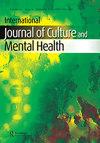智利半农村人口躯体症状高发及其与抑郁和焦虑的关系
Q1 Social Sciences
International Journal of Culture and Mental Health
Pub Date : 2018-03-21
DOI:10.1080/17542863.2018.1444658
引用次数: 1
摘要
我们的目的是研究智利半农村地区精神障碍的患病率,重点是躯体症状及其与社会支持的关系。我们研究了796名1974年至1978年间出生在智利利马切的成年人。采用《患者健康问卷-9》、《广泛性焦虑障碍问卷-7》、《患者健康问卷-15》和《医疗结果研究社会支持量表》分别评估抑郁、焦虑、躯体症状和社会支持。我们发现心身症状的患病率在女性中为63.8%(其中大多数在严重范围内),在男性中为34.1%。抑郁和焦虑的比例分别为17.7%和21.7%。心身症状与抑郁症密切相关(男性OR:10.33, CI 95%: 2.91-34.54;女性OR:6.19,可信区间95%:2.64-14.52)和焦虑(男性OR:2.63,可信区间95%:1.04-6.63;女性OR:3.97, CI 95%: 2.02-7.78)。心身症状与功能障碍之间的关联主要是由于抑郁和焦虑症状。精神障碍与社会支持呈负相关。我们得出结论,心身症状是常态,尤其是在女性中。精神障碍患者的社会支持略低,但仍被认为是高的。在这些社区中,身体上的抱怨往往是抑郁和焦虑的表现。本文章由计算机程序翻译,如有差异,请以英文原文为准。
High prevalence of somatic symptoms in a semi-rural Chilean population and its association with depression and anxiety†
ABSTRACT Our purpose was to study the prevalence of mental disorders with an emphasis on somatic symptoms and their association with social support in a Chilean semi-rural area. We studied a sample of 796 adults born between 1974 and 1978 in Limache, Chile. The Patient Health Questionnaire-9, the Generalized Anxiety Disorder-7, the Patient Health Questionnaire-15 and the Medical Outcomes Study Social Support Scale test were used to assess depression, anxiety, somatic symptoms and social support, respectively. We found that the prevalence of psychosomatic symptoms was 63.8% in women (most of them in the severe range) and 34.1% in men. The rates of depression and anxiety were 17.7 and 21.7%, respectively. Psychosomatic symptoms were strongly associated with depression (male OR:10.33, CI 95%:2.91–34.54; female OR:6.19, CI 95%:2.64–14.52) and anxiety (male OR:2.63, CI 95%:1.04–6.63; female OR:3.97, CI 95%:2.02–7.78). The association between psychosomatic symptoms and functional impairment was mainly due to symptoms of depression and anxiety. Mental disorders were inversely associated with social support. We conclude that psychosomatic symptoms were the norm, especially in women. Social support is marginally lower in those with a mental disorder, but still perceived as high. Physical complains in these communities are frequently the expression of depression and anxiety.
求助全文
通过发布文献求助,成功后即可免费获取论文全文。
去求助
来源期刊

International Journal of Culture and Mental Health
Social Sciences-Cultural Studies
CiteScore
2.10
自引率
0.00%
发文量
0
期刊介绍:
This title has ceased (2018). This important peer-review journal provides an innovative forum, both international and multidisciplinary, for addressing cross-cultural issues and mental health. Culture as it comes to bear on mental health is a rapidly expanding area of inquiry and research within psychiatry and psychology, and other related fields such as social work, with important implications for practice in the global context. The journal is an essential resource for health care professionals working in the field of cross-cultural mental health.Readership includes psychiatrists, psychologists, medical anthropologists, medical sociologists, psychiatric nurses and social workers, general practitioners and other mental health professionals interested in the area. The International Journal of Culture and Mental Health publishes original empirical research, review papers and theoretical articles in the fields of cross-cultural psychiatry and psychology. Contributions from the fields of medical anthropology and medical sociology are particularly welcome. A continuing dialogue between members of various disciplines in various fields is encouraged. The aim of the journal is to encourage its readers to think about various issues which have clouded cross-cultural development of ideas. The journal lays special emphasis on developing further links between medical anthropology, medical sociology, clinical psychiatry and psychology, and implications of the findings on service provisions. The journal is published four times a year. The style of reference is Harvard. All research articles in this journal, including those in special issues, special sections or supplements, have undergone rigorous peer review, based on initial editor screening and anonymized refereeing by at least two independent referees.
 求助内容:
求助内容: 应助结果提醒方式:
应助结果提醒方式:


